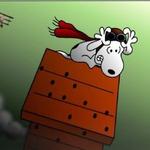Ok. Bevor ich zum Äußersten komme, noch ein wenig Lektüre.
Da ihr ja alle Englisch könnt, gehts auch schon direkt los:
Wikipedia: Copernican heliocentrismPhilolaus (4th century BCE) was one of the first to hypothesize movement of the Earth, probably inspired by Pythagoras' theories about a spherical, moving globe. Aristarchus of Samos in the 3rd century BCE had developed some theories of Heraclides Ponticus (speaking of a revolution by Earth on its axis) to propose what was, so far as is known, the first serious model of a heliocentric solar system
revolution of earth - ging es darum und um "nichts" anderes?
It is a common idea that the heliocentric view was rejected by the contemporaries of Aristarchus. This is due to Gilles Ménage's translation of a passage from Plutarch's On the Apparent Face in the Orb of the Moon. Plutarch reported that Cleanthes (a contemporary of Aristarchus and head of the Stoics) as a worshipper of the Sun and opponent to the heliocentric model, was jokingly told by Aristarchus that he should be charged with impiety.
worshipper of the sun- na kommt uns das nicht bekannt vor? Näheres dazu im nächsten Post.
Several Islamic astronomers questioned the Earth's apparent immobility,[6][7] and centrality within the universe.[8] Some accepted that the earth rotates around its axis, such as Abu Sa'id al-Sijzi (d. circa 1020).[9][10] who invented an astrolabe based on a belief held by some of his contemporaries "that the motion we see is due to the Earth's movement and not to that of the sky."[10][11]
Na sieh mal einer an - auch damals stand man vor demselbn Dilemma - was dreht sich nun? die Erde oder doch nur der Himmel?
According to the geometers [or engineers] (muhandisīn), the earth is in constant circular motion, and what appears to be the motion of the heavens is actually due to the motion of the earth and not the stars.[10]
Copernicus cited Aristarchus and Philolaus in an early manuscript of his book which survives, stating: "Philolaus believed in the mobility of the earth, and some even say that Aristarchus of Samos was of that opinion."[14]
Inspiration came to Copernicus not from observation of the planets, but from reading two authors. In Cicero he found an account of the theory of Hicetas. Plutarch provided an account of the Pythagoreans Heraclides Ponticus, Philolaus, and Ecphantes. These authors had proposed a moving Earth, which did not, however, revolve around a central sun. When Copernicus' book was published, it contained an unauthorized preface by the Lutheran theologian Andreas Osiander. This cleric stated that Copernicus wrote his heliocentric account of the Earth's movement as a mere mathematical hypothesis, not as an account that contained truth or even probability.
Na so was.
However, there is no evidence that Copernicus himself considered the heliocentric model as merely mathematically convenient, separate from reality.
Was Kopernikus glaubte und empfand ist scheißegal, er hatte damals zu beweisen, dass seine Hypothesen in der Realität funktionierten und das gelang ihn so wie es aussieht nicht.
Ibn al-Shatir's lunar and Mercury models are also identical to those of Copernicus.[18] This has led some scholars to argue that Copernicus must have had access to some yet to be identified work on the ideas of those earlier astronomers. However, no likely candidate for this conjectured work has yet come to light, and other scholars have argued that Copernicus could well have developed these ideas independently of the late Islamic tradition.[
Oh nein, meine Lieben, Kopernikus ist da ganz sicher nicht von selbst draufgekommen.
The state of the question as received by Copernicus is summarized in the Theoricae novae planetarum by Georg von Peuerbach, compiled from lecture notes by Peuerbach's student Regiomontanus in 1454 but printed only in 1472. Peuerbach attempts to give a new, mathematically more elegant presentation of Ptolemy's system, but he does not arrive at heliocentrism. Regiomontanus himself was the teacher of Domenico Maria Novara da Ferrara, who was in turn the teacher of Copernicus.
Wikipedia: Copernican heliocentrismMerkt euch mal die Namen.
Und dann gab es noch das:
Sacrobosco's De sphaera mundi was the most successful of several competing thirteenth-century textbooks on this topic, it was used in universities for hundreds of years and the manuscript copied many times before the invention of the printing press; hundreds of manuscript copies have survived. The first printed edition appeared in 1472 in Ferrara, and at least 84 editions were printed in the next two hundred years,
The 'sphere of the world' is not the earth but the heavens, and Sacrobosco quotes Theodosius saying it is a solid body, it is divided into nine parts: the "first moved" (primum mobile), the sphere of the fixed stars (the firmament), and the seven planets, Saturn, Jupiter, Mars, the sun, Venus, Mercury and the moon. There is a 'right' sphere and an oblique sphere: the right sphere is only observed by those at the equator (if there are such people), everyone else sees the oblique sphere. There are two movements: one of the heavens from east to west on its axis through the Arctic and Antarctic poles, the other of the inferior spheres at 23° in the opposite direction on their own axes.
Wikipedia: De sphaera mundi23° !!! N kommt euch das bekannt vor? Über 500 Jahre später sagt man uns folgendes:
Die Erde hängt schief im All! Wenn man sich die Erdumlaufbahn von der Seite anschaut, dann sieht man: Die Erdachse zeigt nicht gerade nach oben, sondern die Erde ist um etwa 23 Grad zur Seite gekippt – aber warum?
Als die Erde frisch entstanden war, stand die Achse noch gerade. Doch Wissenschaftler vermuten, dass sie in der Frühzeit des Sonnensystems von einem großen Asteroiden getroffen wurde. Er traf die Erde etwas seitlich, so dass sie ein Stück kippte – eben diese 23,5 Grad. Außerdem hat der Aufprall einen Teil der noch flüssigen Erde herausgerissen und in eine Umlaufbahn geschleudert, daraus wurde der Mond.
https://www.planet-schule.de/mm/die-erde/Barrierefrei/pages/Warum_steht_die_Erde_schief.htmlNein, meine lieben Freunde das ist nicht aus einem Sketch zitiert von Monty Python sondern von Planet-Schule.
An dieser Stelle schöne Grüße an
@Pan_narrans und seine Schüler.
Aber es geht noch weiter:
The world, or universe, is divided into two parts: the elementary and the ethereal, the elementary consists of four parts: the earth, about which is water, then air, then fire, reaching up to the moon. Above this is the ethereal which is immutable and called the 'fifth essence' by the philosophers. All are mobile except heavy earth which is the center of the world.
https://wikivisually.com/wiki/De_sphaera_mundiDas fünfte Element - der Äther
Und dann:
Mit achtzehn Jahren schrieb Kopernikus sich an der Universität Krakau (Kraków) ein, wo er vier
Jahre lang Mathematik, Astronomie und „den Aristoteles“ studierte.
Bevor er Polen verließ, ernannte ihn sein Onkel zum Kirchenadministrator in Frauenburg.
Mit 24 Jahren begann Kopernikus, Kirchenrecht an der Universität Bologna zu studieren.
Er wohnte zu dieser Zeit im Haus des Mathematikers Domenico Maria de Novara. Domenico Maria
beschäftigte sich mit den im 2. Jahrhundert verfassten Schriften des Astronom Ptolemäus und
setzte sich kritisch mit diesen auseinander. Dies weckte Kopernikus' Interesse für Geographie und
Astronomie. Gemeinsam beobachteten die beiden Männer am 9. März 1497 die Bedeckung des
Sternes Aldebaran durch den Mond. Er zweifelte daraufhin an der bisherigen Theorie der Bewegung
der Himmelskörper um die Erde.
www.fundus.org/pdf.asp?ID=11005
Also mit anderen Worten. Wenn der Mond sich am Himmel entlangbewegt und siehe da er verdeckt einen Stern- dann beweist das: die Erde ist es die sich dreht und bewegt, nicht etwa der Mond. Bestechende Logik.
Aber es kommt noch dicker:
www.fundus.org/pdf.asp?ID=11005
Er wurde im Laufe der Zeit immer sicherer, dass die Erde nicht Mittelpunkt des Weltalls sei
und sich vielmehr selbst dreht. Doch er wollte absolut sicher sein, wollte seine Beobachtungen und
Berechnungen weiterführen, bis er einen Beweis in den Händen hatte. Die Grundlage für alle seine
Erkenntnisse bildeten die Himmelsbeobachtungen, die Kopernikus nur mit den allereinfachsten
Mitteln vornehmen konnte. Zur Beobachtung der Bewegungen der Himmelskörper ließ er Schlitze in
das Dach seines Studierzimmers im Turm des Domes schneiden. So konnte er nachts beobachten,
wie die Sterne über die Schlitze hinwegzogen. Er verfolgte ihre Bahn am Himmel und stellte die
Geschwindigkeit ihrer scheinbaren Bewegung fest. Das Fernrohr wurde erst fast hundert Jahre
später erfunden.
Also sieht er von seinem Schafzimmer aus, wie die Himmelskörper und Sterne über ihn des nachts hinwegziehen - was beweist: die Erde dreht sich.
Also wenn ihr eurem Kind eine Sternenhimmel Nachtlichtlampe kauft und ihr seht im Dunkeln wie die Sternchen an der Zimmerdecke entlangwandern, dann seid gewiss: es ist das Bett des Kindes oder auch der gesamte Fußboden, der sich dreht!
So entwickelte er das heliozentrische Weltbild (Mit der Sonne als Bezugspunkt), das die von
Ptolemäus konzipierte geozentrische Vorstellung (Erde als Bezugspunkt) vom Universum ablösen
sollte.
Kopernikus: „In der Mitte von allen aber hat die Sonne ihren Platz. Wer könnte nämlich diese
Leuchte in diesem herrlichsten Tempel an einen anderen oder gar besseren Ort setzen, als an den,
von dem aus sie das ganze zugleich beleuchten kann? Nennen doch einige sie ganz passend die
Leuchte der Welt, andere ihr Herz, wiederum andere ihren Lenker. So lenkt in der Tat die
www.fundus.org/pdf.asp?ID=11005
Lest euch mal das Zitat durch: Was für Fakten, was für handfeste Beweise! Die Sonne als Mittelpunkt von allem - halleluja!
noch so ein whorshipper of the sun
Mit 27 Jahren hielt Kopernikus in Rom Vorlesungen über
Astronomie. Im darauffolgenden Jahr wurde er zum Medizinstudium in Padua zugelassen (an
derselben Universität, wo ein Jahrhundert später Galileo lehrte).
www.fundus.org/pdf.asp?ID=11005
Copernicus had started out as Novara's student and then became his assistant and co-worker. Novara in turn declared that his teacher had been the famous astronomer Regiomontanus, who was once a pupil of Georg Purbach. Novara was initially educated in Florence, at the time a major center of Neoplatonism, he studied there under Luca Pacioli, a friend of Leonardo da Vinci.
https://wikivisually.com/wiki/Domenico_Maria_Novara_da_FerraraAlso mit anderen Worten, die ganzen berühmten Globe theorists kommen aus einem Stall.
Wikipedia: Copernican heliocentrismHowever, for his contemporaries, the ideas presented by Copernicus were not markedly easier to use than the geocentric theory and did not produce more accurate predictions of planetary positions. Copernicus was aware of this and could not present any observational "proof", relying instead on arguments about what would be a more complete and elegant system. The Copernican model appeared to be contrary to common sense and to contradict the Bible
eegant system - aber nicht mehr
Tycho, arguably the most accomplished astronomer of his time, appreciated the elegance of the Copernican system, but objected to the idea of a moving Earth on the basis of physics, astronomy, and religion. The Aristotelian physics of the time (modern Newtonian physics was still a century away) offered no physical explanation for the motion of a massive body like Earth, but could easily explain the motion of heavenly bodies by postulating that they were made of a different sort of substance called aether that moved naturally.
Wieder Äther
Likewise, Tycho took issue with the vast distances to the stars that Copernicus had assumed in order to explain why the Earth's motion produced no visible changes in the appearance of the fixed stars (known as annual stellar parallax). Tycho had measured the apparent sizes of stars (now known to be illusory – see stellar magnitude), and used geometry to calculate that in order to both have those apparent sizes and be as far away as heliocentrism required, stars would have to be huge (the size of Earth's orbit or larger, and thus much larger than the sun). Regarding this Tycho wrote, “Deduce these things geometrically if you like, and you will see how many absurdities (not to mention others) accompany this assumption [of the motion of the earth] by inference.
Thus many astronomers accepted some aspects of Copernicus's theory at the expense of others. His model did have a large influence on later scientists such as Galileo and Johannes Kepler, who adopted, championed and (especially in Kepler's case) sought to improve it.
During the 17th century, several further discoveries eventually led to the wider acceptance of heliocentrism:
Using the newly invented telescope, Galileo discovered the four large moons of Jupiter (evidence that the solar system contained bodies that did not orbit Earth), the phases of Venus (the first observational evidence not properly explained by the Ptolemaic theory) and the rotation of the Sun about a fixed axis[43] as indicated by the apparent annual variation in the motion of sunspots;
With a telescope, Giovanni Zupi saw the phases of Mercury in 1639;
Kepler in 1609 introduced the idea that the orbits of the planets were elliptical rather than circular, while retaining the heliocentric concept.
Isaac Newton in 1687 proposed universal gravity and the inverse-square law of gravitational attraction to explain Kepler's elliptical planetary orbits.
Nein, diese aufgeführten Ereigniss beweisen NICHT das Heliozentrische Weltbild. Phasen des Merkurs, elliptische Bahnen oder "Gravity" gehören zu der unbeweglichen flachen Erde
Whether Copernicus' propositions were "revolutionary" or "conservative" has been a topic of debate in the historiography of science. In his book The Sleepwalkers: A History of Man's Changing Vision of the Universe (1959), Arthur Koestler attempted to deconstruct the Copernican "revolution" by portraying Copernicus as a coward who was reluctant to publish his work due to a crippling fear of ridicule.
Oh war es ihm etwas peinlich diesen Quatsch zu veröffentlichen. Kann man ihm nicht übel nehmen.
Thomas Kuhn argued that Copernicus only transferred "some properties to the Sun's many astronomical functions previously attributed to the earth."[citation needed] Other historians[who?] have since argued that Kuhn underestimated what was "revolutionary" about Copernicus' work, and emphasized the difficulty Copernicus would have had in putting forward a new astronomical theory relying alone on simplicity in geometry, given that he had no experimental evidence.
beides:
Wikipedia: Copernican heliocentrismSo viel dazu. Es lohnt sich da mal tiefer einzutauchen, dann findet ,an so einiges. Und ich sag euch: Hier stinkts!




















